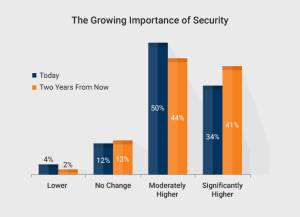Politics
How Artificial Intelligence Testing is Top-Notch in Cyber World
Published
2 years agoon
By
Drew Simpson
In the cybersecurity sector, artificial intelligence testing is crucial. This is because AI has the potential to help cybersecurity overcome some of its major obstacles. And there are many obstacles, including the incapacity of many organizations to stay on top of the numerous new risks and attacks that emerge as the internet and technological usage increase.
AI-powered cybersecurity is expected to change how we respond to cyber attacks. Because of its capacity to study and learn from enormous volumes of data, artificial intelligence will be crucial in identifying sophisticated threats. Moreover, AI testing is an all-in-one answer to safeguard these gadgets from malicious actors, as new technology and gadgets are always available.
This blog will walk you through the difficulties that the cybersecurity sector is now facing, the significance of employing Artificial Intelligence testing to overcome those difficulties and some of the drawbacks of doing so. Finally, we shall examine some actual applications of AI in this area before we conclude.
An Overview of the Cybersecurity Industry
Cybersecurity describes the processes followed by people or organizations to safeguard their online-connected computer hardware and software against cyberattacks.
The proliferation of emerging digital technologies like the Internet of Things (IoT). The rising frequency and intricacy of cyberattacks and rigorous data protection laws for data security. An uptick in attacks that target software supply chains is the key driver of the cybersecurity market.
In addition, the COVID-19 pandemic has increased the incidence of malicious attacks on databases in large enterprises. They are necessitating tighter database protection and fostering the expansion of the cybersecurity industry. In healthcare, banking, insurance, manufacturing, and financial services, growth in adopting organization security solutions is provident.
Some Intriguing Figures Related to Cybersecurity
- The amount of money spent on internal cybersecurity operations is anticipated to increase by 7.2% annually till 2026.
- By December 2026, it is familiar that global spending on cybersecurity services and products will increase by 8.4%. The necessity to fix the network, app, and system vulnerabilities as a result of ongoing corporate and individual cyberattacks are elements that are likely to promote growth.
- The cybersecurity industry was estimated to be worth $156.24 billion in 2020 and is anticipated to grow at a CAGR of 14.5 percent from 2021 to 2026, reaching $350.25 billion.
- Information security products and services generated $144 billion in revenue in 2018, down 12.4% from 2017, according to Gartner Inc.
- According to Gartner’s predictions, information security revenue will increase from $124 bn in 2019 to $170.4 bn in 2022. Additionally, according to their analysis, end-user expenditure on cloud security increased by 4.1 percent between 2020 and 2021.
Glaring Cybersecurity Challenges
You may be surprised to learn that human mistake accounts for 95% of cybersecurity breaches, according to a Google survey. These mistakes might include everything from downloading a virus-filled email attachment to using a weak password to access an unsafe website. According to studies, phishing attacks are among the most common cyber events, CEO fraud, stolen computers, and ransomware assaults. The effects of these attacks are stunning, even though they may seem easy to handle. In small and medium businesses (SMBs), data breaches cost, on average, $3.9 million. The top four are the top four: large-scale data monitoring, a slower turnaround, a lack of threat understanding, and organizational compliance standards.
Delving Into Common Cybersecurity Attacks
Cybercrime is always changing, with hackers constantly refining their tactics to cause the most harm, complicating the issues outlined in the previous section. Malware that could modify its source to evade detection made up 93.67% of the malware observed in 2019. Additionally, within the same year, 53% of consumer PCs and 50% of commercial computers both relapsed the infection. To eradicate this virus from its source, action and awareness are vital.
We should all be aware of the following examples of the typical cybersecurity threats that clever hackers have cleverly created.
• Phishing
When a hacker uses the social engineering technique of phishing, they send you an email that contains a dangerous link. By clicking the link, you could give them access to your computer so they can infect it with a bug and steal all of your personal data.
• Hardware and Software Attacks
If your system’s hardware and software are not updated to the most recent versions, missing critical security updates can be a risk. It can be introduced to “back doors” or “trojans” and obtain access to the system.
• Network Intrusions
Data going to and from a network endpoint can be hindered by malicious actors and decrypted. If they aren’t caught in time, they might alter it, tamper with it, or use it illegally.
• Cloud Data Breaches
Since more people are using private and public clouds, unencrypted data stored there is an open invitation to malicious hackers. Data saved in the cloud can also be composed due to unreliable interfaces or APIs, insufficient access control, and inadequate security architecture.
• Mobile Malware
Mobile devices’ internal operating systems may become unreliable due to this dangerous malware, which could reduce their functionality. This frequently occurs as a result of URLs being insecure online. In addition, downloaded applications with security flaws also contribute to mobile virus problems.
• Ransomware Attacks
One of the most common types of cyberattacks is ransomware, in which the attackers send a virus into people’s personal laptops and smartphones to access and use the data on those devices. They then want a ransom to give you access to it again.
How Can Artificial Intelligence Testing Enhance Cybersecurity?
A notable benefit of AI testing is that it significantly reduces some labor-intensive jobs known to be time-consuming, such as security monitoring, which is unquestionably a significant time-sink for IT security experts. AI testing can do this repetitious labor instead of humans having to keep an eye on numerous gadgets. To enforce proper cybersecurity, decrease attack surfaces, and detect malicious behavior, AI and machine learning testing need to be in collar.

Let’s look at some additional crucial areas where AI testing proves to be of the utmost significance:
• Moving a vast amount of information around
Each day, data of over 2.5 quintillion bytes are produced. Artificial intelligence (AI) technologies can assist in automating data processing. It makes sense of vast amounts of data that would be impossible for humans to understand in a usable manner. Security experts cannot evaluate and classify every piece of information because firms face millions of risks. As a result, it is tough for security specialists to foresee dangers before they destroy IT systems. Artificial intelligence testing can identify numerous cyber-security threats and issues without human analysts.
• Behavioral analytics
By analyzing how users typically interact with their devices, ML algorithms are intelligent enough to learn and create a pattern of user behavior.
AI testing flag the user as suspicious and possibly block them if it notices unexpected behaviors that are out of the ordinary. These actions include altering the user’s typing speed or attempting to access the system at odd times.
• Ability to analyze and comprehend data
AI testing analyzes millions of events and detects a wide range of threats. These threats include malware that exploits zero-day vulnerabilities, phishing attempts, and malicious code downloads. As a result, AI and ML have emerged as essential information security technologies. Companies may better understand dangers and respond to them faster thanks to these insights. It also helps them adhere to the best security procedures.
• Detection of spam
Spam detection, as well as other types of social engineering aided by natural language processing(NLP), is a subfield of deep learning.
In general, NLP employs a variety of statistical techniques and extensively learns typical verbal and nonverbal communication patterns to identify and prevent spam content.
• Systems for detecting and preventing intrusions (ID/IP)
These systems can detect harmful network activity, guard against intrusions, and warn users of potential dangers. Systems using ID and IP frequently prove useful in addressing data breaches and improving the security of user information.
Furthermore, it is feasible to guarantee a more effective operation of ID/IP systems by utilizing deep learning, recurrent, and convolutional neural networks. The methods above will make it easier for security teams to distinguish between safe and risky network activity. In addition, it improves traffic analysis accuracy and decreases false alarm frequency.
• Speedy detection of numerous types of threats
When it comes to hacking networks, cybercriminals are becoming more skilled and quick. The use of cutting-edge technology, such as machine learning, makes it easier to detect cyberattacks. However, it is hard for humans to keep track of every connected system for every possible hazard. These data are used to educate AI-powered devices, which can then learn from real and digital world data.
Wrapping Up: AI Testing Potential in Cybersecurity

Given the rising interest in AI in cybersecurity, it’s realistic to assume that in the future, we’ll see even more sophisticated solutions capable of resolving difficulties in the business that is even more difficult and complex. By automating threat detection, artificial intelligence testing will strive to save cybersecurity and contribute to internet safety.
IT security professionals now utilize AI to reinforce sound cybersecurity procedures. It reduces the attack surface and tracks malicious activity. In addition, it evaluates and deals with massive volumes of data and assesses human behavior.
This is by no means a comprehensive list of its functions. It’s preferable to embrace technology today and keep up with the times if you want to be more prepared for the AI-testing cybersecurity future.
Featured Image Credit: Provided by the Author; Thank you!
Timothy Joseph
Technical Writer At QASource
I am Timothy Joseph, a testing expert with over 10 years of experience in QASource. In a nutshell, a techie who enjoys studying the pinnacles of current technology & creativity!
You may like
-


Google DeepMind wants to define what counts as artificial general intelligence
-


Enabling enterprise growth with data intelligence
-


NSA launches AI security center amid growing cyber threats
-


Everything you need to know about artificial wombs
-


The Download: brain bandwidth, and artificial wombs
-


Indian Cyber Force Targeting Canadian Sites, and Other Cybercrimes
Politics
Fintech Kennek raises $12.5M seed round to digitize lending
Published
7 months agoon
10/11/2023By
Drew Simpson
London-based fintech startup Kennek has raised $12.5 million in seed funding to expand its lending operating system.
According to an Oct. 10 tech.eu report, the round was led by HV Capital and included participation from Dutch Founders Fund, AlbionVC, FFVC, Plug & Play Ventures, and Syndicate One. Kennek offers software-as-a-service tools to help non-bank lenders streamline their operations using open banking, open finance, and payments.
The platform aims to automate time-consuming manual tasks and consolidate fragmented data to simplify lending. Xavier De Pauw, founder of Kennek said:
“Until kennek, lenders had to devote countless hours to menial operational tasks and deal with jumbled and hard-coded data – which makes every other part of lending a headache. As former lenders ourselves, we lived and breathed these frustrations, and built kennek to make them a thing of the past.”
The company said the latest funding round was oversubscribed and closed quickly despite the challenging fundraising environment. The new capital will be used to expand Kennek’s engineering team and strengthen its market position in the UK while exploring expansion into other European markets. Barbod Namini, Partner at lead investor HV Capital, commented on the investment:
“Kennek has developed an ambitious and genuinely unique proposition which we think can be the foundation of the entire alternative lending space. […] It is a complicated market and a solution that brings together all information and stakeholders onto a single platform is highly compelling for both lenders & the ecosystem as a whole.”
The fintech lending space has grown rapidly in recent years, but many lenders still rely on legacy systems and manual processes that limit efficiency and scalability. Kennek aims to leverage open banking and data integration to provide lenders with a more streamlined, automated lending experience.
The seed funding will allow the London-based startup to continue developing its platform and expanding its team to meet demand from non-bank lenders looking to digitize operations. Kennek’s focus on the UK and Europe also comes amid rising adoption of open banking and open finance in the regions.
Featured Image Credit: Photo from Kennek.io; Thank you!
Radek Zielinski
Radek Zielinski is an experienced technology and financial journalist with a passion for cybersecurity and futurology.
Politics
Fortune 500’s race for generative AI breakthroughs
Published
7 months agoon
10/11/2023By
Drew Simpson
As excitement around generative AI grows, Fortune 500 companies, including Goldman Sachs, are carefully examining the possible applications of this technology. A recent survey of U.S. executives indicated that 60% believe generative AI will substantially impact their businesses in the long term. However, they anticipate a one to two-year timeframe before implementing their initial solutions. This optimism stems from the potential of generative AI to revolutionize various aspects of businesses, from enhancing customer experiences to optimizing internal processes. In the short term, companies will likely focus on pilot projects and experimentation, gradually integrating generative AI into their operations as they witness its positive influence on efficiency and profitability.
Goldman Sachs’ Cautious Approach to Implementing Generative AI
In a recent interview, Goldman Sachs CIO Marco Argenti revealed that the firm has not yet implemented any generative AI use cases. Instead, the company focuses on experimentation and setting high standards before adopting the technology. Argenti recognized the desire for outcomes in areas like developer and operational efficiency but emphasized ensuring precision before putting experimental AI use cases into production.
According to Argenti, striking the right balance between driving innovation and maintaining accuracy is crucial for successfully integrating generative AI within the firm. Goldman Sachs intends to continue exploring this emerging technology’s potential benefits and applications while diligently assessing risks to ensure it meets the company’s stringent quality standards.
One possible application for Goldman Sachs is in software development, where the company has observed a 20-40% productivity increase during its trials. The goal is for 1,000 developers to utilize generative AI tools by year’s end. However, Argenti emphasized that a well-defined expectation of return on investment is necessary before fully integrating generative AI into production.
To achieve this, the company plans to implement a systematic and strategic approach to adopting generative AI, ensuring that it complements and enhances the skills of its developers. Additionally, Goldman Sachs intends to evaluate the long-term impact of generative AI on their software development processes and the overall quality of the applications being developed.
Goldman Sachs’ approach to AI implementation goes beyond merely executing models. The firm has created a platform encompassing technical, legal, and compliance assessments to filter out improper content and keep track of all interactions. This comprehensive system ensures seamless integration of artificial intelligence in operations while adhering to regulatory standards and maintaining client confidentiality. Moreover, the platform continuously improves and adapts its algorithms, allowing Goldman Sachs to stay at the forefront of technology and offer its clients the most efficient and secure services.
Featured Image Credit: Photo by Google DeepMind; Pexels; Thank you!
Deanna Ritchie
Managing Editor at ReadWrite
Deanna is the Managing Editor at ReadWrite. Previously she worked as the Editor in Chief for Startup Grind and has over 20+ years of experience in content management and content development.
Politics
UK seizes web3 opportunity simplifying crypto regulations
Published
7 months agoon
10/10/2023By
Drew Simpson
As Web3 companies increasingly consider leaving the United States due to regulatory ambiguity, the United Kingdom must simplify its cryptocurrency regulations to attract these businesses. The conservative think tank Policy Exchange recently released a report detailing ten suggestions for improving Web3 regulation in the country. Among the recommendations are reducing liability for token holders in decentralized autonomous organizations (DAOs) and encouraging the Financial Conduct Authority (FCA) to adopt alternative Know Your Customer (KYC) methodologies, such as digital identities and blockchain analytics tools. These suggestions aim to position the UK as a hub for Web3 innovation and attract blockchain-based businesses looking for a more conducive regulatory environment.
Streamlining Cryptocurrency Regulations for Innovation
To make it easier for emerging Web3 companies to navigate existing legal frameworks and contribute to the UK’s digital economy growth, the government must streamline cryptocurrency regulations and adopt forward-looking approaches. By making the regulatory landscape clear and straightforward, the UK can create an environment that fosters innovation, growth, and competitiveness in the global fintech industry.
The Policy Exchange report also recommends not weakening self-hosted wallets or treating proof-of-stake (PoS) services as financial services. This approach aims to protect the fundamental principles of decentralization and user autonomy while strongly emphasizing security and regulatory compliance. By doing so, the UK can nurture an environment that encourages innovation and the continued growth of blockchain technology.
Despite recent strict measures by UK authorities, such as His Majesty’s Treasury and the FCA, toward the digital assets sector, the proposed changes in the Policy Exchange report strive to make the UK a more attractive location for Web3 enterprises. By adopting these suggestions, the UK can demonstrate its commitment to fostering innovation in the rapidly evolving blockchain and cryptocurrency industries while ensuring a robust and transparent regulatory environment.
The ongoing uncertainty surrounding cryptocurrency regulations in various countries has prompted Web3 companies to explore alternative jurisdictions with more precise legal frameworks. As the United States grapples with regulatory ambiguity, the United Kingdom can position itself as a hub for Web3 innovation by simplifying and streamlining its cryptocurrency regulations.
Featured Image Credit: Photo by Jonathan Borba; Pexels; Thank you!
Deanna Ritchie
Managing Editor at ReadWrite
Deanna is the Managing Editor at ReadWrite. Previously she worked as the Editor in Chief for Startup Grind and has over 20+ years of experience in content management and content development.
